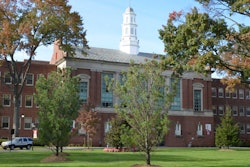Report: American Higher Ed System
Falling Behind World Rivals
By Charles Dervarics and David Pluviose
The United States is taking a back seat to Japan, Korea and other global rivals when it comes to educating its citizens, according to a recent report from the National Center for Public Policy and Higher Education.
The report also notes persistent gaps in access and achievement between Whites and students of color in many states and finds that fast-rising college tuition is putting college out of reach for many would-be students.
In “Measuring Up 2006: The National Report Card on Higher Education,” a national group of experts says the nation’s younger, more diverse population is not academically prepared to take over for the better-educated baby boom generation.
“The report card’s findings challenge the notion that the American higher education system is still the best in the world,” says James B. Hunt Jr., chair of the center’s board of directors and former governor of North Carolina.
“In such key areas as college access and completion, the U.S. has made little or no progress, while other countries have made substantial gains,” he adds. “Our country must not remain satisfied with past achievements or reputation. We can and must mobilize our nation, our states and our colleges for success in this global competition.”
The center’s new report is the fourth in a series and the first to make in-depth comparisons between U.S. and international students. The study finds that though the United States is still at the head of the pack in the proportion of its citizens age 35 to 64 with a college degree, the country is only seventh on this measure among 25- to 34-year-olds.
Several nations have overtaken the United States in terms of college access, and the country ranks in the bottom half of countries in college completion comparisons.
However, Dr. Laura M. Desimone, professor of public policy and education in the Department of Leadership, Policy and Organizations at Vanderbilt University, says the study’s comparisons between U.S. students and students abroad are erroneous.
“You have many systems — and it varies by country — where beyond ninth grade, and sometimes lower, there’s a very extreme sorting mechanism so that only the brightest or the most privileged students have access to the best schools, so you’re really not comparing apples to apples,” she says.
Desimone adds that while the United States should do more to train students in hard science and mathematics, the country should be applauded overall for its higher education system.
“We provide incredible access to higher education in this country through community colleges, through second chances and through our state university systems — I think it’s important that we don’t lose sight of that,” she says.
The report also provides a state-by-state snapshot, which shows that
many states are lagging in minority enrollment and achievement. In Colorado, for example, only 17 percent of 18-to-24-year-old minorities enroll in higher education. The rate for Whites is 40 percent. In New Jersey and Pennsylvania, students of color trail Whites in enrollment by 20 and 18 percentage points, respectively.
College degree data show similar disparities. In Texas, for example, 35 percent of White adults have at least a bachelor’s degree, compared with 16 percent of non-Whites.
Broken down by income, poor students fare even worse in some states. Sixty-one percent of high-income students in Ohio attend college, compared with just 20 percent of low-income students.
The report echoes the concern of many that the soaring cost of higher education in the United States is shutting too many students out of the nation’s best schools. The center gave the vast majority of states — 43 — an “F” on affordability.
The study finds that since the early 1990s, most states declined on college affordability measures, as the percentage of family income needed to pay net college costs at public four-year colleges increased dramatically. For instance, the average Ohio family dedicates 42 percent of family income to pay for a student’s college costs this year, compared to 28 percent in 1992.
© Copyright 2005 by DiverseEducation.com


















